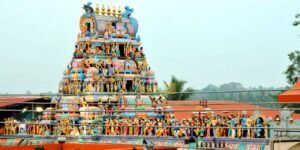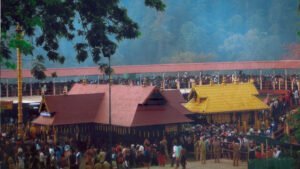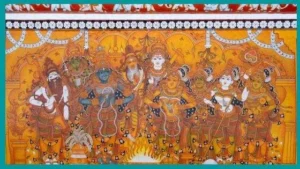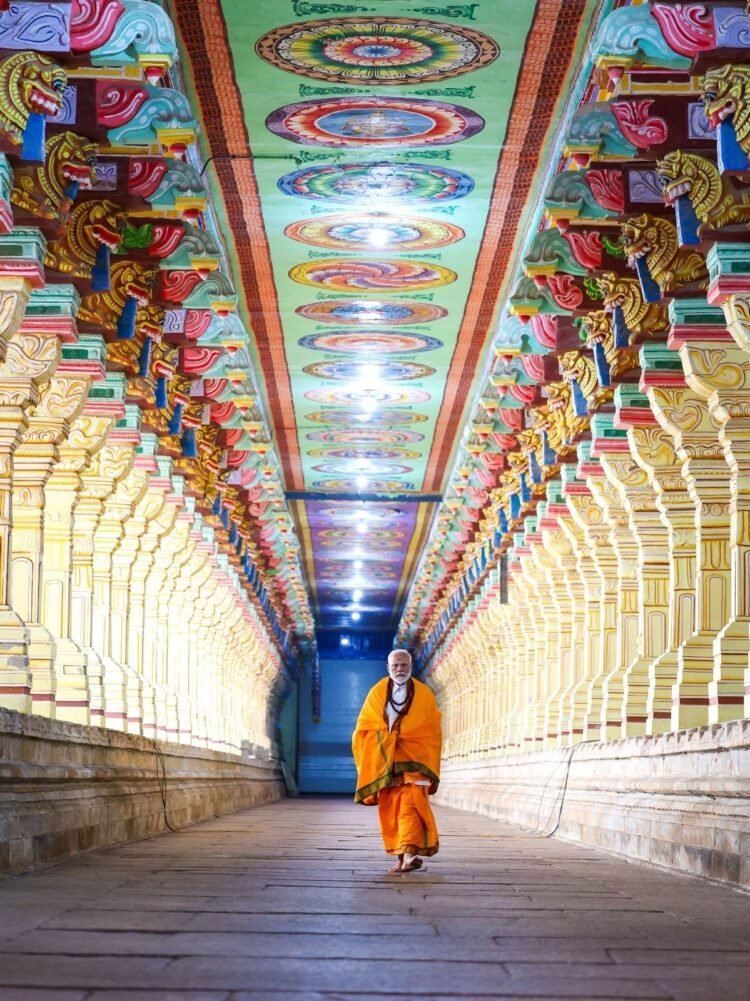No products in the cart.
Kerala’s Ancient Hindu Temple: The Power of Faith
KERALA
The Power of Faith
Kerala is home to some of India’s oldest Hindu shrines. Many of the shrines which remain living temples are testimony to an unbroken chain of religious rituals and ceremonies passed on from generation to generation over millennia. The temples also reflect the high importance given to them by the kings as an economic centre and symbol of their power and reach amongst their subjects.
Sree Padmanabhaswamy Temple 
Located in the coastal state capital of Thiruvananthapuram, in 2011 this ancient temple, emblazoned both national and international headlines of untold riches made over millennia. While sensational news such as this gave the media much fodder, what is undeniable is that the collection of that wealth also reflects the deep veneration and love the people held for the deity over the centuries.
It was under the orders of the Supreme Court for the need for greater transparency in the management of the temple, that the subterranean vaults (kallara) were for the first time opened to the public gaze, rather than just that of royalty and the high priests, as was always won’t for times immemorial. Of the eight extant hidden cellars, Vault A’s treasures alone were valued at around ₹1 lakh crore. Vault B remains closed, surrounded by mystery and mystique.
Golden thrones and crowns, ceremonial attire for the deity, jewels of extraordinary beauty, the most precious gemstones on earth, statues of gold and silver embedded with precious gems; artifacts from the Chera, Pandya, and Greek and Roman eras, amongst them gold coconut shells studded with rubies and emerald; and coins, in gold and silver as well as hundreds and thousands of them from Rome—all this and more was offered to please the deity, Lord Padmanabha. The opening of the vaults, yielding what might be a fraction of its treasure has not put an end to decades of conjecture about the riches of this leading shrine which fell under the purview of Travancore royals. However, these donations to the temple were not for the personal use of the royals or the high priests, but only for public welfare.
As was custom many of the items would be routinely removed temporarily to be pressed into service on special ceremonial occasions such as temple festivals and the like and when all was done, they were reverentially returned to the vaults, six of which are opened eight times a year for this purpose still. Two vaults have remained tightly shut for centuries.
To put things in perspective, the donation of his wealth (which would also include land) acquired by conquest or by taxes, to the temples was a power statement for the king which also helped rally his subjects around him through the deity’s blessings. Temples with their haul of wealth became primary centres of economic power as well, which royalty could share to get the support of the people.
Faith is a great mover and even royalty regarded it as an essential ingredient in capturing the loyalty of the people, for the faith of even the lowliest soul in the kingdom drives the popularity of temples in all Kerala. Raja Marthanda Verma of Travancore in 1749 dedicated his kingdom to Lord Padmanabhan and became his dedicated servant; the family were custodians of the temple till 1971 when the custodianship was taken over by Kerala state. Even after India’s independence, the temple continued to be governed by a trust controlled by the erstwhile royals.
In 2020, the apex court upheld the right of the erstwhile royal family of Travancore to “manage and administer” the Sree Padmanabhaswamy Temple. the state government was also directed to establish a trust to take control of the temple, its assets, and management and to run the temple according to traditions.
Open only to Hindus, the world’s richest temple is one of the 108 Vaishnav pilgrimage hubs for the worshippers of Lord Vishnu. Lord Padmanabhan is a manifestation of Lord Vishnu, the Preserver, the third of the primary trinity, of the Hindu pantheon which includes Lord Brahma the Creator, and Lord Shiva the Destroyer. Not many people are aware that the original name of Thiruvananthapuram was Ananthasyanam after Lord Vishnu, the tutelary deity of the royals of Travancore
Though its origins are lost in the mists of time mentions are traced in the ancient Puranas and literature of the Sangam era in the 1st and 2nd century CE; a major source are the venerated works of Nammalwar, the 9th century Tamil poet-saint.
Within the sanctum of the gilded temple the ruling deity, a 15-foot-long Vishnu, created from 12,008 salagrams (sacred stones), reclines on the 5-headed serpent Adishesha. From his navel emerges a lotus and a seated Lord Brahma. Attended by his two consorts the Goddess of Prosperity and Bhudevi the Goddess of Earth, Vishnu rests his sheltering right hand over a Shiv lingam.
Another unique aspect of this imposing temple, located in the fort area in the southern reaches of the city, is the seamless blend of Dravidian and Kerala architectural features. You can see the influences of Kerala architecture in the 80ft high gold leaf Dhwaja Sthambham or the flagstaff raised near the front mandapam, and the Chuttambalam or structures surrounding the sanctum. A spectacle of majesty is the stunning Dravidian style 7-tiered gopuram vaulting into the skyline at a height of 35 m. topped by seven golden domes; in the first story murals are depicted the 10 manifestations of Lord Vishnu. A multi-pillared open corridor or sivelipura in the outer parikrama, would serve as a sacred pathway for the deity to be taken out in procession.
An unmissable experience is the reverential deeparadhana, the lighting of the evening lamps in the sanctum.
A huge draw is the annual Alpasi Festival, typically held in Oct/Nov. The festivities involve the deities in the shining Aarattu ceremony–the holy bath in the sea, at the famous Shanghumugham Beach. Its colourful pageantry is marked by the presence of the head of the Travancore royals wielding a ceremonial sword as he leads the procession.
Attukal Bhagavathy Temple
Just 2km away from the Padmanabhan Temple this serene spiritual hub is dedicated to the supreme mother, the Goddess Kannaki, a manifestation of the goddess Parvati, consort of Lord Shiva. It celebrates the empowerment of the female as the source of the creation of all living beings. Its claim to fame is also for holding the Guinness World Record for the single largest congregation of women for religious activities.
Sabarimala Sastha Temple
Pilgrims are directed to undertake a rigorous fast for 41 days to make their dream of visiting the Sabarimala Sastha Temple come true. You’ll be one of the 50 million-odd visitors annually, who make the trip here from all over the world. Located amidst the thickly forested expanses of the Sahya hill (Sahyadri) range in the Pathanamthitta District of Kerala, it’s one of the most important temples in Kerala as legend has it that Lord Ayyappa himself meditated here for years after having killed the demoness Mahishi. Lord Ayyappa is revered for appearing in 16 different manifestations, including that of the Buddha.
The story goes that Shiva was so enamoured by the beauty of Vishnu he asked him to appear to him in the female form, which he does as Mohini. Ayyappa is said to have been the result of that celestial union. The boy lived as Dharma Saastha in Kailash, the abode of Lord Shiva. He was reborn as a baby, abandoned on the banks of the Pampa River, as an answer to the prayers of a childless King Rajashekahar of Pandalam. Picking up the baby the king took it as a miracle and carried the boy back to the palace and named him Manikanda. Many miracles were attributed to the child who grew up in the palace, but he became a thorn in the flesh of his foster mother who tried to get rid of him in many ways. When Manikanda revealed his celestial parentage, the king wished to raise a temple dedicated to him. He is also revered as “Hariharputhra”, son of Vishnu (Hari) and Shiva (Hara).
The Ayyappa Temple, accessible only by foot from Pamba, resounds with the footfalls of streams of devotees from November to mid-January, the height of the pilgrim season. The temple is open to people of all faiths. An Ayyappa Swamy is a pilgrim who has been initiated by a Guru Swamy (someone who has visited Sabarimala before).

Guruvayur Sree Krishnaswamy Temple
Located in Thrissur, the Guruvayur Sree Krishnaswamy Temple enshrines the beloved Lord Guruvayurappan. The shrine, whose origins are a candle in the wind, is considered highly auspicious as devotees hold it veneration as Bhuloka Vaikuntham or ‘Holy Abode of Vishnu on Earth’. One legend has it a tiny idol was rescued from the floodwaters of a drowning Dwarka and brought here by Vayu, lord of the Winds and the Guru (mentor to the Gods), and installed and consecrated at a spot sanctified by Lord Shiva, who willingly shifted to nearby Mammiyoor. Krishna is the eighth manifestation of Vishnu. Little wonder the Guruvayur Sree Krishnaswamy Temple is hailed as the ‘Dwarka of the South’; the shrine, it is believed, has healing powers for the mentally unstable. The walls of the sanctum feature beautiful murals from the 17th century featuring vignettes of Lord Krishna’s life. While people certainly enjoy the annual festivities like Guruvayoor Ekadashi, Vaishakam, and Ashtami Rohini, the famous Guruvayoor Aanayottam or elephant race is unique.
Lord Rama Shrines In Kerala Shree Ramaswami TempleThe shrine here at Thriprayar, in Thrissur District features Lord Ram as the four-armed Vishnu holding a conch, a disc, a bow, and a garland, after vanquishing the demon, Khara. This Lord Rama also holds the title of Khara Samhara Moorthy. Traces of Shiva and Brahma from the symbols in the imagery reflect nuances of the sacred Hindu triumvirate of Lord Brahma Lord Vishnu, and Lord Shiva. Devotees hold the belief that the idol was consecrated by Lord Rama himself and even Lord Krishna is said to have worshipped here. Lighting of firecrackers is one of the rare forms of offerings here to Lord Rama. The 7-day pooram festivities at the Shree Ramaswami Temple, nestling by the Karuvannur River, are held in March/April; people arrive in droves to witness the snake boat race during the Onam festival held in Aug/ Sept
Thiruvangad Sree Ramaswamy Temple The Thiruvangad Sree Ramaswamy Temple, located at Thalasseri, in Kannur District, is dedicated to Lord Rama. The roof of this ‘Brass Pagoda’ is a sheet of copper. The shrine is an alluring sight for its plethora of beautiful sculptures, detailed wood carvings, and delightful murals adorning the wooden ceilings. Thiruvangad Sree Ramaswamy is also venerated as Thiruvangad Perumal, the supreme force of southern 'Thattakam' among the five deities of yesteryears Cannore, or Kolathnadu— the "Five Friendly Northern Rulers" Nilesvaram, Kumbla, Vitalh, Bangor, and Chowtwara. Rama is worshipped here as Lord Vishnu, the idol of which is carved from black stone or Krishna Shila, a common occurrence in ‘idolising’ the deity. There is a prevalent belief that the idol was installed by Lord Parashuram; other stories have it that it was Swetha Muni, a disciple of Agasthya Muni. The Thiruvangad Ekadasi Festival is held with great pomp and show attracting thousands of devotees. Sree Ramaswamy Temple,
Located at Karimpuzha in Palakkad District the temple is venerated as the ‘Dakshin Ayodhya’ or Ayodhya of the South. temple holds a beautiful image of lord Rama in the circular sanctum (srikovil). The annual eight-day festivities at the shrine are held in the Malayalam month of Kumbham (mid-February – mid-March). The idol depicts sacrificing Lord Rama, renouncing life at the Sarayu River before his ascent to heaven. Hanuman was with the Lord in his last moments, so the shrine also features an idol of the Monkey God.
Sree Rama Temple The picturesque setting of the Sree Rama temple at Ponkuzhi offers a rewarding darshan to many devotees who can enjoy the serene beauty of the Ponkuzhi River running alongside the Sulthan Bathery-Mysuru road. Just 4km away lies the beautiful Muthanga Wildlife Sanctuary. The primary object of worship, Lord Rama, also has in attendance his companions in exile, consort Sita, brother Lakshman, and Hanuman his fierce devotee. The sarovar, or sacred pond is said to have been created by the tears of a sorrowing Sita. Legend has it that this was the place where Rama is said to have rejected a pregnant Sita and abandoned her in the forest. When the Sage Valmiki learned from his disciples how they found her alone and weeping, he took her to his hermitage. Sita in time gave birth to Lava and Kush under the sage’s protection. The Sita Devi Lava-Kush Temple, at Pulpally nearby, was built by a respectful Vedarajan, the king of hunters. Thiruvilwamala Vilwadrinatha Temple
Located in Thrissur district this temple features the twin idols of Lord Rama and his brother Lakshman in the 2-tiered srikovils. The 5-foot-high Rama is carved from area stone known as Pathalanjana Sila. The idol of Lord Rama in the west-facing shrine is a swayambhu (self-emanating) image. This is the only temple in Kerala where Lord Rama has a swayambhu image.
















